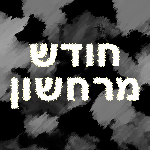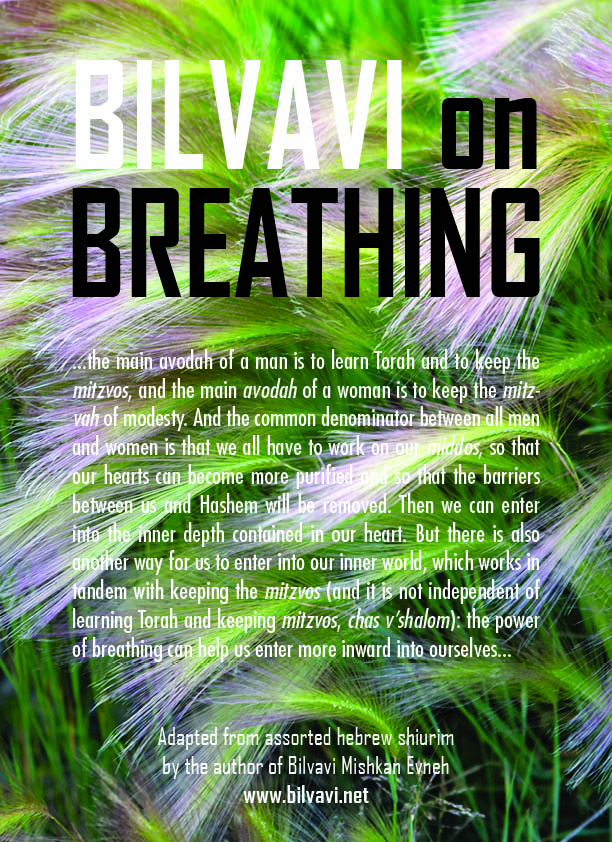Joy from the Four Elements - 001 Intro
- 4016 reads
- Printer-friendly version
- שלח דף במייל
The Root Path of Self-Improvement: Working With The Four Elements
We will begin to study the four elements.
There are many different approaches when it comes to self-improvement. In these lessons, we will be taking the path of the Gedolim throughout the generations, which based all of avodah on the system of the “four elements”. Although there is truth to all other paths of the Gedolim, which did not place any emphasis on the four elements, those paths dealt with the “branches”, whereas the path we will be taking in these lessons is the root of all those paths. Let us first cite the sources for this path.
The Sources
The Rambam, (in Hilchos Yesodei HaTorah 4:1) writes that all of Creation consists of fire, water, wind (air), and earth. The nature of fire is hot and dry, air is hot and moist, water is cold and moist, and earth is cold and dry. Earth is the heaviest element, water is lighter, air is even lighter, and fire is the lightest of the elements. All matter in Creation is formed from a combination of these four elements. This is not only true for the physical body, but also for the soul.
Rav Chaim Vital (Shaarei Kedushah 2:1) writes that the four elements are also in the soul, and they are the root of all character traits, whether good or bad. Thus, all of our good and bad middos are rooted in the four elements of fire, water, air and earth in our soul.
The Maharal (in Derech HaChaim 1:2) writes that there are three active elements, water, air, and fire, as stated in Sefer Yetzirah, and that all creations come from these elements. Sefer Yetzirah, attributed to Avraham Avinu, is the earliest source for the three active elements. The Tikkunei HaZohar, and R’ Chaim Vital, the student of the Arizal, established that the four elements are the pillar of all our avodah (Divine service).
In these lessons, we will also be taking this path.
External and Internal Ways of Avodah
There is an external way of avodah, and an internal way of avodah.
The external way contains many details. The internal way consists of one structure, an all-inclusive structure which includes all details, like a puzzle that contains all the pieces. We can see in the physical world many different things, but from the inner perspective, all of Creation is nothing but the four elements of fire, water, air and earth. This should become the way we view Creation. Superficially, we see many different things in front of us, but when we have the inner perspective, we can see it all as four elements. This is an overhaul to our entire perspective on how we view things.
It is the same when we consider our soul. From a superficial perspective, we are aware that there are thousands of abilities in our soul – such as joy, sadness, silence, anger, patience, etc. There are good middos and bad middos and we need to fix each middah. That is the external, superficial perspective, and one might have this perspective even after many years of learning many different sefarim about improving middos. But according to the inner perspective, Rav Chaim Vital’s, there are only four possible sources in the soul for every possible character trait – the elements of fire, water, air and earth. There are only these four elements, and the interplay of the four elements produces all of the many different aspects of the soul.
One way of avodah with our souls is the external way, and it does not involve the four elements. There are many such ways of avodah we recognize.
For example, there is one method of avodah which bases all of our avodah on the ability to think positively. This is based on the Chassidic statement, “Think good, and it will be good.”[1] Another way of avodah bases all of our avodah on using the imaginative faculty.[2] There are many other methods of avodah as well, which essentially base all of a person’s avodah on a particular power of the soul. The gentiles in particular tend to take these approaches, when it comes to self-improvement and working with the soul. Some of these ways are more truthful, and some are less truthful, but all of them attempt to solve all issues in the soul through using one particular ability in the soul.
Another way of avodah is for a person to take apart each aspect of the soul and to work with it individually, such as by trying to uproot one’s conceitedness, or by trying to uproot anger, etc.[3] This way is also truthful, but it is only working with the branches, and not with the root.
There is another way of avodah: to work with the four elements. This approach works with the roots. The elements are called yesodos, the “foundations”, because they are the basic foundations of the soul – they are the roots to work with.
The Middos Are Results of The Elements
Each of the elements has its own properties which produce different middos (character traits). The middos in the soul are essentially the results of the various properties of the elements.
Even more so - and even more importantly - the elements are not simply independent from each other. Rather, they each relate to the other elements and combine with them. Therefore, fire also contains water, air and earth, and water also contains fire, air, and earth, etc.
For example, water breeds the trait of desire, the nature of seeking pleasure. But water also contains the other elements, so the trait of desire will also contain the “fire” of water, the “air” of water, and the “earth” of water. If desire would only come from the element of water and with no other factors involved, then we would only need to understand the element of water in order to tackle the trait of desire. But there is also desire that comes from the “fire” within the element of water, and there is also desire which comes from the “air” within the element of water, etc. So there are different kinds of desires - even though they are generally rooted in ‘water’.
Whether we are dealing with a good middah or a bad middah, any middah consists of all four elements. For example, the trait of love primarily comes from the soul’s element of water, but since water contains the other elements, there is also a love that comes from the “fire” of water, and a love that comes from the “air” of water, etc. So whenever we analyze any middah, we need to know its root element and how it is composed of all four elements. Whenever we deal with improving a middah, we need to work with its root element.
Also, since all the elements contain the other elements, we also need to know the other divisions of the elements within each middah. The Arizal taught that each of the elements contains all four, and each of those four divides into another four, endlessly. However, we find that our Sages defined a total of 16 divisions for each element. So if we are examining joy, or love, or enthusiasm, we need to see the 16 different types of that trait, which are the roots of that trait.
The Purpose Of This Series
We are learning about this for the purpose of studying, although we won’t be able to actualize the lessons right away. So what is the purpose of this studying? The first stage is to learn about it in general, on an intellectual level, the second stage is to identify it on a personal level, and the third stage is to actualize the lessons. By studying this series, you will be able to accomplish the first two stages – learning about these ideas, and later identifying with them personally – but the actual inner work will be your own.
We will also be giving advice along the way, but the main purpose for now is to study these matters and personally relate to them. The eventual goal is to act upon these lessons, of course, but practically speaking, we cannot do that right now, so we will mainly be studying and identifying with the concepts. It is essentially about developing our souls. Eventually we will aim to be fixing the issues in our souls, but the first step is to learn about the issues that come from our four elements, and to personally identify with them.
Understandably, for every new matter we learn about, there will be difficulties. The Sages said that “All beginnings are difficult.” But long before we arrive at the practical conclusions from each lesson and how to apply it to ourselves personally, we will certainly gain a certain pleasure, clarity, and stability just from studying about these matters.
[1] Editor’s Note: attributed to a statement of Rabbi Nachman of Breslev.
[2] Editor’s Note: This was the approach of Rav Klonimis Kalman Shapira, in sefer Chovos HaTalmidim and in sefer Hachsharas Avreichim.
[3] Editor’s Note: This was the approach of the baalei mussar. See for example sefer Cheshbon HaNefesh
NOTE: Final english versions are only found in the Rav's printed seforim »











